#epicene gender
Explore tagged Tumblr posts
Text
what being epicene means to me
so, hi! i'm epiceneandroid: a tumblr user defined by my identity as an epicene, well, android.
epicene has a lot of meanings, both personal to me and others and dictionary definition. its dictionary definition has a plurality of meanings, including, but not limited to:
-has characteristics of both male and female but is neither gender;
-has characteristics of both masculine and feminine but is neither;
-has both and neither masculine and feminine characteristics;
-has both and neither male and female characteristics;
-genderless or sexless;
-gender indeterminate;
-androgynous;
-gender neutral or neuter;
-unisex;
or a gender like male or female, but is neither.
of course, an epicene person can relate to any, multiple, or even all of those meanings, and still be epicene, and no two epicenes, just like no two women or men, will define their gender the same way.
however, i see my epicenity, as i've grown up over the years, beyond just "has characteristics of both male and female, but is neither" and "gender indeterminate".
think of those gender spectrum charts, like say, a circle. on one end is male, on one end is female, on one end is neutrois, on one end is aporagender, etc...the very center of the circle, in the middle of + having aspects of every gender but not BEING every gender like pangender, is epicene to me, i've discovered.
so it's a gender that has aspects of male, female, androgyne, femache, neutrois, aporagender, maverique, agender, really, countless genders, without being exactly all of those genders and being sort of its own thing. it's kind of like an aporagender that is simultaneously NOT an aporagender. it's kind of a schrodinger's abinary sort of thing, as it has aspects of genders that have nothing to do with binary masculinity/maleness or femininity/femaleness, but also has aspects of genders that HAVE relation to masculinity/maleness and femininity/femaleness at the same time. but, again, it's only ASPECTS of it, not exactly the exact gender. so epicenity is sort of like an abinary/midbinary combination, or a nontrinary gender, on the surface, but moreso...to me, an anonbinary experience.
so yeah. this is how i view my own epicenity. i wonder if other epicene people view their gender the same way.
#my gender#epicene#epicene gender#epin#epingender#if any epicene people relate to this they can reblog it if they'd like! i think i have a pretty unique take on epicenity because i see it a#lying outside of midbinary neutrality AND abinary androgyny and being sort of an anonbinary pangender in nature thing
32 notes
·
View notes
Note
could i get some plain versions of your Transepicene flags? thx
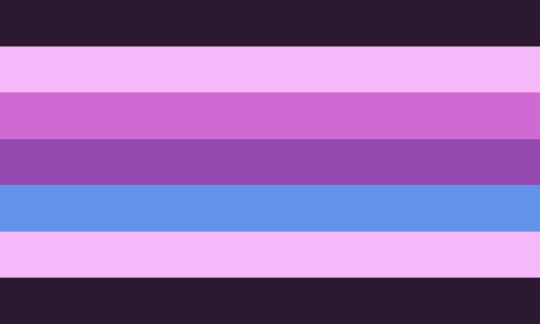
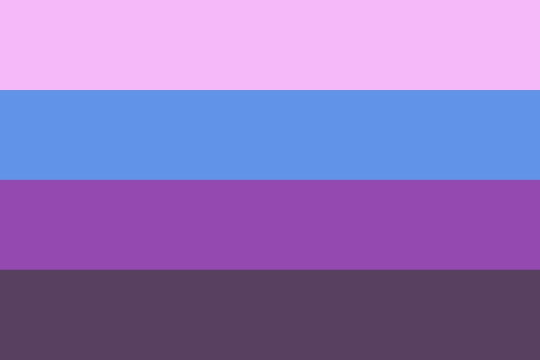
Here you are anon!
Link to the original post/flags with symbol here
#transepicene#trans#epicene#epicene gender#mogai flags#liom flags#mogai flag#liom flag#mogai friendly#liom friendly#iso.ask
9 notes
·
View notes
Text
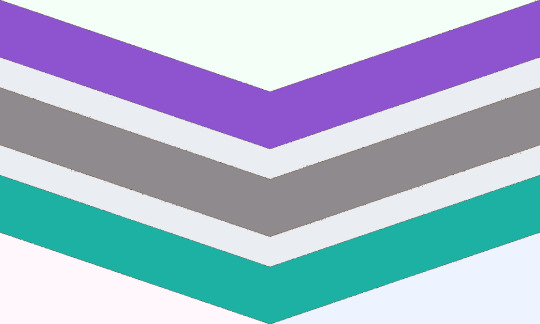
[Image ID: the Trinteri pride flag by Gent of Gender-Jargon. The Trinteri flags consists of three down-pointing chevrons of the same size, with negative space above, between and to the left and right bottom corner of the flag. The top negative space is very light green. The left-botton negative space is very light pink. The right-bottom negative space is very light blue. The chevrons from top to bottom are indigo, grey and teal with very very light grey space in between. ./. End ID]
Trinteri: a gender amidst the Gender Trinary; a gender that is centered in the middle of the Male-Female-Neutrois trinary.
[PT: Trinteri: a gender admist the Gender Trinary; a gender that is centered in the middle of the Male-Female-Neutrois trinary. ./. End PT]
Etymology
[PT: Etymology ./. End ID]
From Latin, "Tri-", a prefix meaning "Three" + "Inter" meaning "Between" + "-i", an English neologistic suffix indicating genderness. Literally "between the three". Coined by Gent (Gender-Jargon) (link) in March 2024.
Elaboration
[PT: Elaboration ./. End ID]
Trinteri was created as a result of this post (link) by @your-bigender-big-brother (link). The post posed the question, "what gender quality is right in the center of the trinary?". Most replied, including myself, neutrangity, while others cited epicenity or neutrœmmity, but the more I thought about it, the more I began to feel like these suggested designations were only approximate and didn't quite get to the root of the question.
As Stormy said emself in eir essay (link) ey wrote, the Gender Trinary contains qualities aside from masculinity, femininity and androgyny. Aside from these three, some others are effeminacy, femmulinity, epicenity, neutrommity, neutremmity, neutrœmmity, gynxemity, androxulinity, gyndroxity, neutrangity, tomboyishness and janegirlishness, to name a couple. This got me thinking, which lead me to coin Trinteri as a centrigender that includes the entire Gender Trinary.
Here is the graphic that Stormy included with eir question, which I edited to add Trinteri in the center for reference:
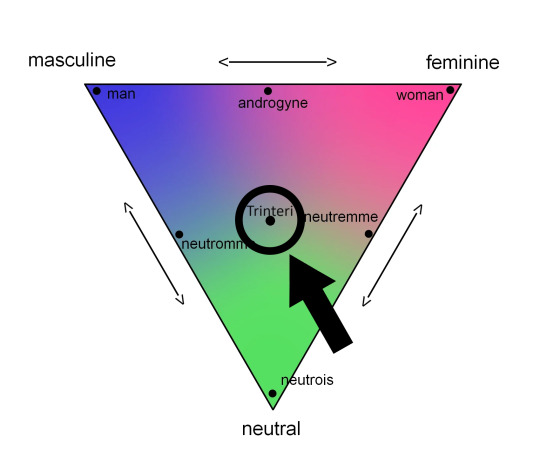
[Image Id: a graphical representation of the Gender Trinary. It is a down-pointing triangle with the left corner labeled "masculine", the right corner labeled "feminine" and the downward-facing point labeled "neutral". Between masculine and feminine, feminine and neutral and masculine and neutral are double-pointing arrows. In the left corner, there is a point labeled "Man". In the right corner, there is a point labeled "Woman". In the downward-facing point, there is a point labeled "Neutrois". Between "Man" and "Woman" is a point labeled "Androgyne". Between "Neutrois" and "Man" is a point labeled "Neutromme". Between "Neutrois" and "Woman" is a point labeled "Neutremme". In the very center, circled and pointed to by a large arrow is a point labeled "Trinteri", which is located at the very center of the diagram. ./. End ID]
I propose the term trinterinity to refer to the quality of gender that is located in the very center of the Gender Trinary. I would be very interested to hear about Stormy's thoughts on this post to see if ey agree, if I missed the mark or if ey have any other kind of feedback for me.
Trinteri is can be considered a midtrinary aporagender. Trinteri is:
a single, specific non-binary identity.
located in the very center of the Gender Trinary of Male-Female-Neutrois.
a centrigender of all trinary gender qualities.
[PT: a single, specific non-binary identity. located in the very center of the Gender Trinary of Male-Female-Neutrois. a centrigender of all trinary gender qualities. ./. End PT]
Trinteri is quite similar to, but distinct from Neutrangi, Neutrœmme and Epicene:
[PT: Trinteri is quite similar to, but distinct from Neutrangi, Neutroemme and Epicene: ./. End PT]
Neutrangi
[PT: Neutrangi ./. End PT]
Neutrangi and Trinteri are both in between Male, Female (rationalized as Androgyne) and Gender-Neutral, but Trinteri is also centered/in between all other trinary genders.
Neutrœmme
[PT: Neutroemme ./. End PT]
Neutrœmme and Trinteri are both in between Male, Female (rationalized as Femache) and Gender-Neutral, but is also centered/in between all other trinary genders.
Epicene
[PT: Epicene ./. End ID]
Epicene is a gender related to Male-Female indeterminance, having characteristics of both Maleness and Femaleness and/or having no characteristics indicative of Maleness or Femaleness. Epicene is a relatively complicated identity, as it can be considered masculine, feminine, androgynous, neutral and a sort of genderless all-in-one.
Both Trinteri and Epicene encompass experiences of masculinity, femininity, androgyny and neutrality, but Trinteri involves all other trinary identities as well. Trinteri is explicitly a centrigender, where as Epicene is generally considered not to be. Epicene is definitively indeterminate with regards to the Male-Female binary, but Trinteri may or may not be indeterminate in it's nature.
Pride Flag
[PT: Pride Flag ./. End PT]
The Trinteri pride flag was created by the coiner at the same time of the term (Gent, GJ, 3/24). The flag consists of three down-pointing chevrons of the same size, with negative space above, between chevrons and to the left and right bottom corner of the flag. The top negative space is very light green. The left-botton negative space is very light pink. The right-bottom negative space is very light blue. The chevrons from top to bottom are indigo, grey and teal with very light grey in between. The colors have the following meanings:
The very light-green negative space represents neutrinity.
The very light-pink negative space represents femininity.
The very light-blue negative space represents masculinity.
The purple chevron represents androgyny.
The grey chevron represents neutremmity.
The teal chevron represents neutrommity.
The very light grey negative space between the chevrons represents the center of the Gender Trinary.
[PT: The very light-green negative space represents neutrinity. The very light-pink negative space represents femininity. The very light-blue negative space represents masculinity. The purple chevron represents androgyny. The grey chevron represents neutremmity. The teal chevron represents neutrommity. The very light grey negative space between the chevrons represents the center of the Gender Trinary. ./. End PT]
#Trinteri#gender trinary#midtrinary#midtrin#mintringender#male#female#neutrois#aporagender#aporine#ain#aingender#centrigender#epicene#androgyne#neutromme#neutremme#neutroemme#trintingender#trintin#trinterine#term#pride flag#microlabel#made by gent#gender coining#coining post#mogai#mogaireal#mogai safe
47 notes
·
View notes
Note
https://commons.wikimedia.org/wiki/File:Genderfluid_symbol.svg
https://commons.wikimedia.org/wiki/File:Pangender_symbol.svg
Can you combine both making a pangenderfluid epicene symbol?

This is what I had in mind. Does this look okay? I know the lines are a bit thick. - 💙💚
9 notes
·
View notes
Text
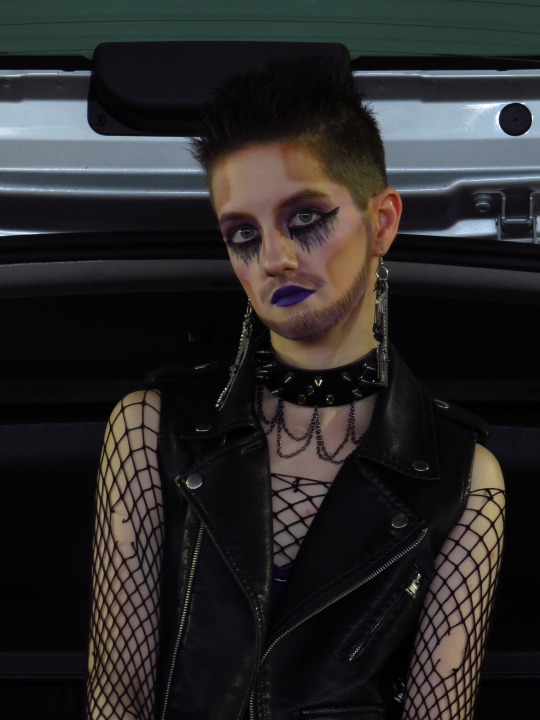
dunno if i sent a pic of me in drag yet but here we are enjoy lmfaooo
i have a drag insta tho (the only reason for me to use meta owned stuff other than keepin up with people i dont rly talk to often on FB): ace_epicene_drag
#ace epicene drag#drag king#this was from like august so its old#can see up-to-date drag pics on my drag insta tho#drag community#lgbtq#any pronouns#nonbinary#gender nonconforming
1 note
·
View note
Text
how i, one of the frequent fronters on this blog, see my gender epicenity
i know, i know. one of the main facets + alters of our most likely osdd system fronted a while back for a LONG time and made a WHOLE long essay on what epicenity means to them. but xe's gone right now; realizing xe's always had health issues that constitute a disability and having other stressors drove it out of front.
so i'm gonna explain to you what epicenity is like to ME, the second most common fronter, a median subsystem apparently normal part facet (though i'm the most emotionally unstable according to most of the anps) of an osdd1b (likely) system who has a LOT of epicene facets and alters.
okay. so epicenity to ME is like a multigender, a monogender, and an agender all at once. it's a multigender of all "both" genders (as in both masculine and feminine AND both male and female), all "neither" genders (as in neither masculine nor feminine AND neither male nor female), all "neuter" genders (like neutrois, neuter, neutre, neugender, neutragender, and gender neutral as examples), all "other" genders (such as other, eligender, not applicable, stuff like that) and all "none" genders (such as agender, gendernull, nullgender, gendervoid, voidgender, none of the above) in existence, while being a monogender at the same time of those things. that means you experience all those genders at the same time, yet feel all those things as simultaneously multiple genders, a singular gender with multiple parts, and something like genderlight where you have so many genders that you are technically NO gender.
that's basically how epicenity works to me. does that make sense to any of my followers on here
2 notes
·
View notes
Text

Exoangi
"An androgynous/androgyne exobinary identity; an androgyne/androgynous gendered folk relating to having experiences of genders that are completely outside of or independent of the binary.
(example experiences can include: nymangis, some interpretations of epicene gender identity, frannchlens, people who have multigenders/centrigenders of androgynous genders and abinary genders, etc)"
A flag requested by @epiceneandroid, who also defined the term for me, made by combining my Exobinary flag ( used for eyestrain reasons ) and this Androgyne flag. Free to use by anyone anywhere as always!
Taglist - @radiomogai, @revenant-coining
#exoangi#exobinary#alibinary#androgyne#androgynous#androgynous gender#abinary#epicene#nymangi#nymgender#frannchlen#centrigender#multigender#mogai pride#liom pride#mogai flag#liom flag#mogai#liom
34 notes
·
View notes
Text
[PT: Moze Pride Flag. End PT]
Moze Pride Flag
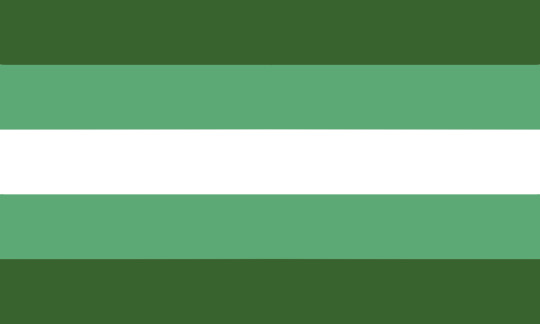
Moze (a neolingual noun parallel with moza and mozo): a monolexical neolabel parallel with man and woman; the epicene/gender neutral of boy and girl; an abinary genderedness apart from male and female.
Cognate of moce/moçe (deriving moça/moço) and moscie (from moscio/moscia). Mocidade (mozeness/moceness) means youth. Since cedilla (ç) is often translated as zed/zee (z), as in Moçambique/Mozambique, because of its Visigothic origin (ꝣ).
In West Iberian the suffixes -o/-a do binarized gender inflection, so any other vowel/letter makes a neutralized declension. Just as in Latinx/Latine.
Alternate words: mozx, moz@, mozu, mozy, mozie, mozone, mozãe, mozane, mozæ/mozae, mozœ/mozoe, moz(s), muchache, muchachx.
Note this isn’t the same as enby, as enby is an abbreviation of nonbinary. Mozes could refer to generic people, such as in pals, however just as in folx, folks might use moze to be a specific non-binary identity. This identity is asynchronously and conceptually epin/nin/oin/abin/uin.
See also: menine, garote/gurie, xicx/xique, niñx/niñe, biche/bixe/beche. - Ap
#referential language#genders#moze#moza#mozo#epicene#nin#needs ID#abinans#abin#mozx#moz@#mozu#mozy#mozie#mozone#mozãe#mozane#mozæ#mozae#mozœ#mozoe#moz#mozs#muchache#muchachx
63 notes
·
View notes
Note
While 4th-person pronouns as a phrase only makes sense a joke(?)reference(?) to the concept of the fourth wall, do you know of any languages that have an actual distinct pronoun for ambiguous or unknown persons (not like ambiguous/unknown gender, but people that you don't know or aren't sure who you're specifically talking about)
I reject the premise of the first sentence here. fourth person pronouns do not make sense as a joke reference to the concept of the fourth wall. the concept of the fourth wall is completely unrelated to the ways in which "chat" is used, and both things are completely unrelated to personal pronouns.
anyway the google search term you're looking for is "(grammatical) epicenity"
160 notes
·
View notes
Text


Today's Gender of the Day is: Neutrangi!
Neutrangi is an identity that exists between androgyne and neutrality. It falls under the multigender umbrella.
If you were to show the gender trinary as a triangle with the points labeled man, woman, and neutral, neutrangi would sit exactly in the center in-between the trinary. While it exists right in this center, neutrangi individuals can experience any amount of masculinity, femininity, and neutrality.
Other identities to look into:
Gynx: A gender that exists between androgyne and female.
Androx: A gender that exists in between androgyne and male.
Juxtaneu: A gender that derives from epicenity or neutrality but is neither.
Paratrinary: A gender that exists outside of but very near to the gender trinary.

6 notes
·
View notes
Text
Alternate Genderqueer Flag
[Pt: Alternate Genderqueer Flag]


I'm not a big fan of the most commonly used genderqueer flag (the lavender, white, green one), for a few reasons:
It's very similar to the UK suffragette flag, which is commonly used by TERFs to signal their trans exclusionism in the modern day, to the extent that emojis in those colors (����⬜🟩) are commonly used in the bios of TERFs online.
The common genderqueer flag focuses on one specific type of genderqueer person (people who fit the definition of nonbinary), rather than broadly including all people whose gender identity, modality, or expression exists outside cultural expectations.
I'm not a huge fan of how the colors look together, though this is much less important than my other concerns.
As a genderqueer person, I wanted to make a genderqueer flag that is more inclusive, less easily confused with symbols adopted by TERFs, and (according to my own preferences) more visually appealing. I put a lot of thought into it, so here's a breakdown of the symbolism behind the stripes.
Lavender represents queerness and the epicene. Lavender is traditionally used to represent LGBTQ+ people, representing queerness. It is also a shade of purple (a combination of red/pink and blue, commonly gendered colors), representing the epicene (people whose identity, self expression, or sex cannot be strictly distinguished as either male or female, masculine or feminine).
This stripe is included at both the top and bottom of the flag, signaling its double meaning, as well as showing that everything between these stripes is encompassed by them.
Blue represents subversive masculinity. Blue is commonly used as a "masculine" color, and is used here to represent masculinity which subverts the expectations placed upon a person due to the circumstances of their birth or development. This includes masculine women, butches, transmasculine people, and anyone else whose masculinity defies the societal expectations placed on them.
White represents transition and inclusion. The white stripe in the trans flag represents the process of transitioning, among other things. In this flag, "transition" can refer to medical transition, social transition, or even just acknowledging to yourself that you're trans. White is also the combination of all light, representing inclusion. This stripe is used twice to signal its double meaning, but its placement among the other stripes was simply chosen for aesthetic reasons.
Yellow represents breaking the binary. Yellow is the opposite of purple (representing the binary in this case, rather than epicenity), showing a rejection or subversion of the gender and/or sex binary. This includes nonbinary people, altersex people, and intersex people whose intersex experience has impacted or "queered" their (relationship to) gender. This stripe was also heavily inspired by the use of yellow in the nonbinary and intersex flags.
Pink represents subversive femininity. Pink is commonly used as a "feminine" color, and is used here to represent femininity which subverts the expectations placed upon a person due to the circumstances of their birth or development. This includes feminine men, femmes, transfeminine people, and anyone else whose femininity defies the societal expectations placed on them.
-
This flag is public domain, and anyone is free to use it for any reason!

Edit: Added a darker version for those who may prefer it!
23 notes
·
View notes
Photo
[PT: astroera: a genderera person whose masculinity is a central part of their identity
stellaera: a genderera person whose femininity is a central part of their identity
lumera: a genderera person whose epicenity is a central part of their identity
exterasterera: a genderera person whose xenity is a central part of their identity
colorera: a xenoera identity related to or aligned with the concept of color. for example, blue-colorera would be someone who is either a) both genderera and bluegender or b) blue-aligned genderera
faera: a xenic genderera person
faunera: a masculine genderera person
nymera: a feminine genderera person
dryaera: an epicenic genderera person. End PT]










astroera | stellaera | lumera exterasterera | colorera | faera faunera | nymera | dryaera
genderera alignment (re)designs!
astroera: a genderera person whose masculinity is a central part of their identity
stellaera: a genderera person whose femininity is a central part of their identity
lumera: a genderera person whose epicenity is a central part of their identity
exterasterera: a genderera person whose xenity is a central part of their identity
colorera: a xenoera identity related to or aligned with the concept of color. for example, blue-colorera would be someone who is either a) both genderera and bluegender or b) blue-aligned genderera
faera: a xenic genderera person
faunera: a masculine genderera person
nymera: a feminine genderera person
dryaera: an epicenic genderera person
dni transcript here
#flags#genders#astroera#gendereras#fein#stellaera#lumera#exterasterera#colourera#colorera#faera#faunera#nymera#dryaera#min#fin#epicene#xin#xenogenders#theme: colours#colourgenders#xenoera#xenic#epicenic#needs ID#long post#Skipping queue.
42 notes
·
View notes
Note
exorsexism and exorsexist ableism is when you explain to your mom you don't see distinctions between gender in your own gender and in sexuality and relationships, that you identify as epicene (which you explain as having male and female aspects while being neither male nor female; god I could never even try to explain to her that I'm angeligender or robotgender or synthesizsergender), that you identify as androgynous, and that you don't care who you date as long as they love you, and your mother says you can't be nonbinary because you're too "intellectually and emotionally immature" and "unable to understand abstract concepts" so she pretty much thinks you're too stupid to identify as nonbinary
this is exorsexism & ableism.
50 notes
·
View notes
Text
*Nonbinary as in any gender identity which does not fit neatly into either of the following categories:
Always, wholly, and exclusively a man.
Always, wholly, and exclusively a woman.
•••••••••••••••••••••••
**Epicene as in gender identity, alignment, and/or expression which does fall into at least one of the following categories:
Incorporating both manhood/masculinity and womanhood/femininity, or falling somewhere in between the two.
Incorporating neither of the two.
Lacking gender distinction, or being ambiguous.
•••••••••••••••••••••••
Anyone can answer this poll, regardless of your own gender!
#genderqueer#nonbinary#non binary#enby#neutrois#gender neutral#gender neutrality#neutral gender#trans#transgender#lgbt#lgbtq#lgbtqia#queer#poll#polls
13 notes
·
View notes
Text
[PT: How I see my gender epicenity. End PT]
How I see my gender epicenity
Epicene as a gender encompasses being ambonec and maverique putting a pinch of mystery (uingender) and equary.
Ambonec for me is being both and neither. It's kinda trigender. Well neither is already in the definition.
Neither encompasses none, abinary and neutrois/neuter, so a mix of genderlessness and aporagender neutrality. Still missing aliagender part of it.
Both mixes femache centrigender, midgender/mesogender, ambigender, ambitrois, ambigue/ambiguity and androgyne into one thing.
Although epicene is vaguely used outside gender identity, as in linguistics and biology it's synonym and associated with promiscuity and thus non-monogamy, but without impurity part epimiceia caused.
Equitrois/equigender (equarity) and mystery because the lack of distinction and indetermination in the definitions of it.
Also a relational orientationgender for me. I also socialize my personhood as xenine and pangender additionally.
It practically means more than one definition, it's all of them. But I will try: alia-ambi-neu-equi-nix-apora-uin-gendernonmono. Nix meaning AGIN (agender) and alia an abinary third-gender. See infinitrois and infinigender.
Tastes like genderpunk too.
16 notes
·
View notes
Text
Gender-Jargon GIN Terms Masterlist
[pt: Gender-Jargon GIN Terms Masterlist ./. End PT]
I said I would do it, so I went ahead and did it.
[PT: I said I would do it, so I went ahead and did it. ./. End PT]
Tagging @imoga-pride and @in-nature-archive.
Here is a list of GIN ([Gender]-in-nature) terms that I used on my old blog (Gender-Resource) for tagging. I have also included more recent GIN terms that either I have coined or has been coined by others that I currently use or likely will use in the future for tagging.
If anyone has any questions about the terms here, just let me know and I would be happy to answer them :-)
Enjoy!
Fin: (Feminine-in-nature)
Unfin: (Unfeminine-in nature)
Troin: (Troinine-in-nature)
Min: (Masculine-in-nature)
Droin: (Droxinine-in-nature)
Unmin: (Unmasculine-in-nature)
Lin: (Androgynous-in-nature)
Unlin: (Unandrogynous-in-nature)
Femain: (Femasline-in-nature)
Ambiguin: (Ambiguine-in-nature)
Altrin: (Altraeninine-in-nature)
Nin: (Neutral-in-nature)
Unin: (Unneutral-in-nature)
Neuin: (Neutrine-in-nature)
Epin: (Epicene-in-nature)
Trinin: (Trinterine-in-nature)
Amin: (Ambiguous-in-nature)
Perin: (Peraine-in-nature)
Ilyin: (Ilyagine-in-nature)
Mvin: (Mavriquine-in-nature)
Auin: (Autonomous-in-nature)
Othin: (Other-in-nature)
Nuin: (Null-in-nature)
Vin: (Void-in-nature)
Agin: (Agender-in-nature)
Glin: (Genderless-in-nature)
Gein: (Generic-in-nature)
Kein: (Kenochoric-in-nature)
Luxin: (Luxine-in-nature)
Inbin: (Inbissiec-in-nature)
Enmin: (Enmitiec-in-nature)
Shocin: (Shocking-in-nature)
Uin: (Undescribable-in-nature)
Din: (Describable-in-nature)
Apin: (Apathetic-in-nature)
Usin: (Confused-in-nature)
Main: (Male-in-nature)
Fein: (Female-in-nature)
Lein: (Femache-in-nature)
Buin: (Butch-in-nature)
Sobin: (Soft Butch-in-nature)
Fuin: (Futch-in-nature)
Femin: (Femme-in-nature)
Bufin: (Butchy Femme-in-nature)
Genoin: (GNC-in-nature)
Qin: (Queer-in-nature)
Ain: (Aporine-in-nature)
Ouin: (Outherine-in-nature)
Diasin: (Diastine-in-nature)
Xin: (Xenine-in-nature)
Oriein: (Orientation-in-nature)
Lexin: (Lexcial-in-nature)
Gsrin: (Gesneriad-in-nature)
Aesin: (Aesthetic-in-nature)
Coriin: (Coric-in-nature)
Whilin: (Whilom-in-nature)
Roin: (Neuroine-in-nature)
Iin: (Intersex Exclusive-in-nature)
Altin: (Altersex-in-nature)
Yin: (Yonderine-in-nature)
Cuin: (Culturally Exclusive-in-nature)
2sin: (Twospirit-in-nature)
Amplin: (Amplusian-in-nature)
Chin: (Changing-in-nature)
Plasmin: (Genderplasmic-in-nature)
Cinn: (Choice-in-nature)
Idin: (Fluid-in-nature)
Uxin: (Flux-in-nature)
Flin: (Fluix-in-nature)
Aporin: (Nonspecific-in-nature)
Porin: (Specific-in-nature)
Unrelin: (Unrelated-in-nature)
Relin: (Related-in-nature)
Plin: (Partial-in-nature)
Poin: (Polygender/Omnigender/Pangender-in-nature)
Antin: (Antigender-in-nature)
Novin: (Novel/New-in-nature)
Infin: (infinite-in-nature)
Doxin (Paradoxical-in-nature)
Oposin (Opposite-in-nature)
Contrin (Contradictory-in-nature)
Vain: (Vague-in-nature)
Vasin: (Vast-in-nature)
Win: (Weak/Disconnected-in-nature)
Reclin: (Reclaimed-in-nature)
Rin: (Rejected/Repulsed-in-nature)
Contrin: (Contraversial-in-nature)
Polin: (Political-in-nature)
Sucuin: (Subcultural-in-nature)
Cocuin: (Countercultural-in-nature)
Quesin: (Questioning-in-nature)
Virin: (Virine-in-nature)
Lierin: (Eraine-in-nature)
Commin: (Commidine-in-nature)
Ithin: (Itherinine-in-nature)
Andin: (Anderine-in-nature)
Diphin: (Dipherine-in-nature)
Umbin: (Umbinine-in-nature)
Pretin: (Preterine-in-nature)
Bin: (Binarine-in-nature)
Nobin: (Nonbinarine-in-nature)
Enbin: (Enbinine-in-nature)
Midbin: (Midbinaraine-in-nature)
Nomidbin: (Nonmidbinarine-in-nature)
Abin: (Abinarine-in-nature)
Noabin: (Nonabinarine-in-nature)
Trin: (Trinarine-in-nature)
Midtrin: (Midtrinarine-in-nature)
Atrin: (Atrinarine-in-nature)
Noatrin: (Nonatrinarine-in-nature)
Tin: (Trans-in-nature)
Cin: (Cis-in-nature)
Trisin: (Tris-in-nature)
Ipsin: (Ipso-in-nature)
Ultin: (Ulter-in-nature)
Iptin: (Ipter-in-nature)
— Gent (link)
[PT: -- Gent (link) ./. End PT]
#GIN#in-nature#gender nature#nature of gender#term#list#masterlist#taglist#tagging#gender-resource#gender-jargon#gender coining#made by gent#mogai#liom#liomogai#for archivists#umbrella term#transgender#gender theory
67 notes
·
View notes